Levittown
From fifties
Levittown (Janice & Megan)
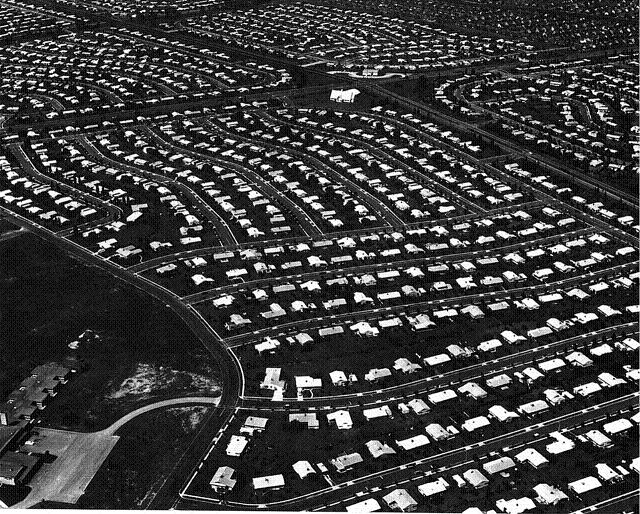 Aerial View of Levittown, Pennsylvania
Aerial View of Levittown, Pennsylvania
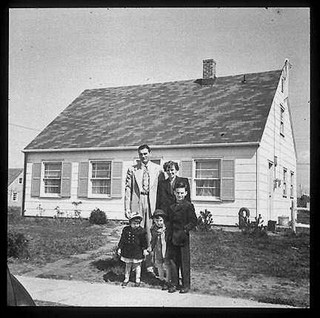 Levittown "All-American" Family
Levittown "All-American" Family
The early Levittowns also had an ugly secret: no black families allowed. "As a Jew, I have no room in my mind or heart for racial prejudice," Levitt insisted in 1954. "But, by various means, I have come to know that if we sell one house to a Negro family, then 90 to 95 percent of our white customers will not buy into the community. That is their attitude, not ours."
One black couple, Bill and Daisy Meyers, was daring enough to buy a Levittown, Pa. house in 1957. They were met by rock-throwers, bomb threats and mobs screaming racist taunts at them. It seemed like the bland facade of middle-class conformity was peeling away — to reveal hatred and fear underneath.
The Levittown "whites-only" policy eventually yielded to political pressure and lawsuits. Levittown, Pa. now has a mere fraction of blacks — just 1.5 percent — but Willingboro is split almost evenly between black and white. In a twist on ‘50s policy, real-estate agents now tout Willingboro's peaceful diversity as an attractive reason to move.
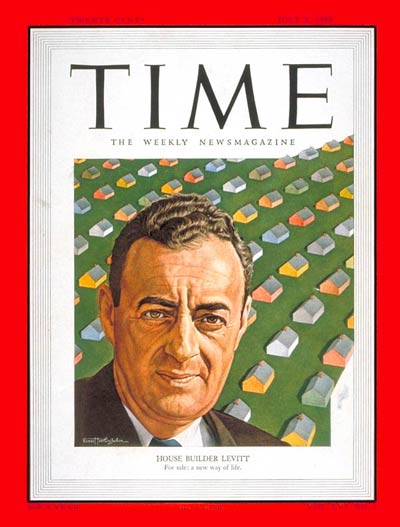 William Levitt made the cover of Time on July 3, 1950
William Levitt made the cover of Time on July 3, 1950
"The family that had the greatest impact on postwar housing in the United States was Abraham Levitt and his sons, William and Alfred, who ultimately built more than 140,000 houses and turned a cottage industry into a major manufacturing process."
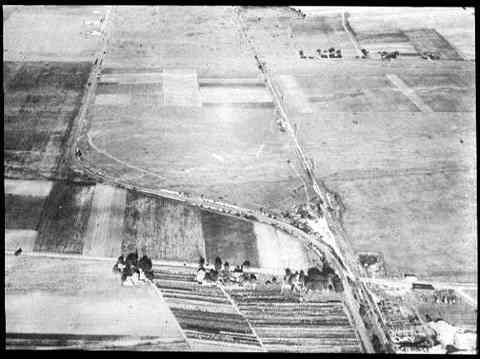 What Once Was A Potato Farm...
What Once Was A Potato Farm...
On July 1, 1947, William Levitt broke ground on his 1200 acre property on Long Island just east of Manhattan. Twenty acres were held for the cutting of lumbar and preparation of products such as cement. In no time at all this land would hold over 1700 homes. To build such an extreme community, Levitt used an extended reverse assembly line method breaking each task required to build a home into 27 different teams/tasks. Instead of the products moving down the line, the teams moved from house to house when it was their time to work. Each team was specialized and skilled to do one specific task. These groups were so specialized that there were even different teams for painting with white and painting with red. Bill Levitt intended to build homes fast- his method accomplished just that. While most builders built on average 3-4 homes a year, Levitt planned to build 30-40 per day. By separating the tasks by team, he was also able to work around unions and high turn over.
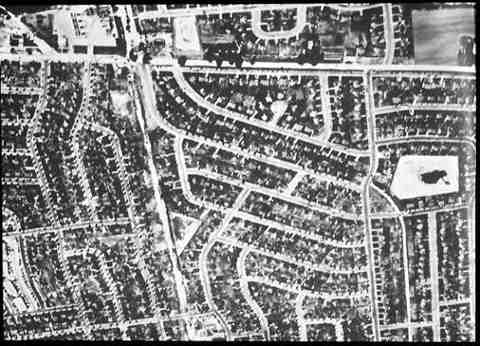 Turned Into William Levitts 1200 Acre Dream Community
Turned Into William Levitts 1200 Acre Dream Community
In response to a strong housing crisis, Bill Levitt was certain that suburban living was the future of American families. It was an extension of the American dream stating, “We believe that the market for custom housing, like that for custom tailoring, no longer exists. People who want to buy that kind of thing will always be able to get it, but the real market is for the ordinary, mass produced suit of clothes.” (Halberstam, page 134)
The first homes within Levittown were open to purchasing for veterans only. Men returning home to their families needed a place to live, a place to make their own and continue building their families. Available apartments and homes in the city were scarce, crowded and far beyond affordable for the average family. Levittown offered families a place where they could live in their very own home including appliances for less than the price of renting an apartment in the city. The cost of the homes fell under $8,000.00 with only a $100.00 refundable deposit required. There were no closing costs and no hidden extras. Bill Levitt was open and transparent in his business and selling points.
On July 1, 1947, William Levitt broke ground on his 1200 acre property located on Long Island, just east of Manhattan. Levitt put aside twenty acres specifically for the cutting of lumbar and the preparation of products, such as cement. In no time at all this land held over 1700 homes. To build such an extreme community, Levitt used an extended reverse assembly line method. This broke down the task of building a home into 27 different teams/duties. Instead of the products moving down the line, the teams moved from house to house when it was their time to work. Each team was specialized and skilled to do one specific task. These groups were so specialized that there were even different teams for painting white and painting red.
Bill Levitt intended to build homes fast and his method accomplished just that. While most builders built on average 3-4 homes a year, Levitt planned to build 30-40 per day. By separating the tasks by team, he was also able to work around unions and high turn over. The cost of building was kept extremely low. The Levitt’s purchased their own forests, thus keeping the cost of lumber to a minimum. They also made their own tools and supplies, such as nails. All home products, refrigerators, ovens, and dishwashers, were purchased from the manufacture to keep the middle man costs out. Bathrooms were strategically placed to reduce costs as well. Instead of placing the bathroom near the bedrooms, they were placed by kitchen to reduce plumbing installation costs.
The first Levittown included 17,000 homes with over 80,000 residents. To create more of a community feel, Bill Levitt made sure to put in public entertainment. He made sure pools were installed, one for every thousand homes. Also built within the Levittown grounds were schools, churches, shopping centers, and post offices. This created more of a small town feel within the neighborhood and promoted greater interaction between the families living there.
While the suburbs would prove to be a god place to raise a family, the early Levittowns were hiding something very shameful: no black families/buyers allowed. "As a Jew, I have no room in my mind or heart for racial prejudice," Levitt insisted in 1954. "But, by various means, I have come to know that if we sell one house to a Negro family, then 90 to 95 percent of our white customers will not buy into the community. That is their attitude, not ours."
While creating the largest housing development of its kind, Bill Levitt not only reduced the housing crisis, he helped to create the norms in neighborhood developments that are seen even to this day. From the layout and structure to the large community based shopping centers, pools and group activities, all of this derived from Levitts dream. Levittown not only allowed the general public to own their own home, it also gave them a sense of community and belonging.
Bibliography:
http://www.capitalcentury.com/1951.html
http://geography.about.com/od/urbaneconomicgeography/a/levittown.htm
http://www.freeenterpriseland.com/BOOK/LITTLEBOXES.html
http://www.time.com/time/magazine/article/0,9171,1704669,00.html
http://www.time.com/time/magazine/article/0,9171,812779,00.html
Halberstam, David. The Fifties. Fawcett Columbine, New York. 1993
